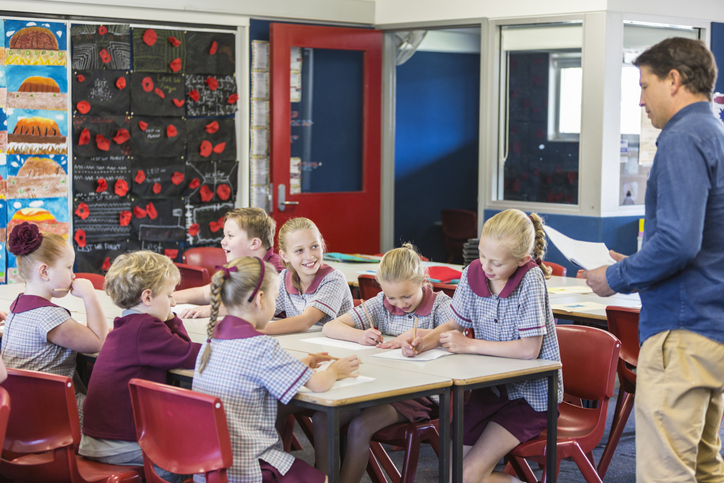
Last week, Treasurer Jim Chalmers and Finance Minister Katy Gallagher credited “responsible economic management” for an historic improvement in Australia's budget outlook, in their 2023-24 Mid-year Economic and Fiscal Outlook (MYEFO).
Australia’s gross debt is predicted to decline to 32.1% of GDP, while the projected deficit drops to $1.1bn, down from $55.4bn under the previous government. Some commentators are even forecasting a second surplus for the Albanese Government.
The money is there
Andy Mison, president Of the Australian Secondary Principals’’ Association (ASPA) says an interesting detail is that the underlying cash balance over four years to 2026/27 is set to improve by $39.5bn relative to May Budget.
“Coincidentally this equates almost exactly to the nearly $40bn in cumulative underfunding of public schools during 2023-28 as identified by Adam Rorris on behalf of the AEU recently,” Mison told The Educator.
Under current arrangements, the Australian Government contributes 80% of School Resourcing Standard (SRS) funding to the Catholic and Independent school sectors, all of whom are funded at or above 100%, with the difference made up from tuition fees and other income sources.
Conversely, states and territories provide up to 75% of the SRS to their public schools, with the Australian Government covering 20%. The 5% shortfall amounts to approximately $6.5bn in real terms annually, and less than 2% of Australian public schools are fully funded, despite 65% of Australian students attending public schools, including the majority of disadvantaged children.
The ramifications of this funding shortfall were highlighted further when, earlier this month, an analysis of the latest OECD PISA data revealed the achievement gap between advantaged and disadvantaged students continues to widen.
“This is an embarrassing trend, given the commitments successive education ministers have made since the 2008 Melbourne Declaration to ‘ensure differences in educational outcomes associated with students’ culture, disability, remoteness, or socioeconomic status are reduced or eliminated’,” Mison said.
“As observed by the Productivity Commission in their January review of the National School Reform Agreement, ‘So far, parties have failed to demonstrate that they are achieving the sub outcomes for students from the priority equity cohorts that they committed to’.”
Mison said a quick scan of the latest budget statements from all state and territory governments reveals the budget optimism is federated.
“All states and territories are also predicting surpluses or progress towards them by the 2026/27 financial year. The OECD ranks Australia as one of the world’s wealthiest countries, and it appears we are getting richer,” he said.
“Dr Chalmers and the Albanese Government have identified boosting the capacity and foundations for growth in our economy as the rationale for their budget priorities. What could be more foundational than investing in our children and young people?”
Australia now has ‘a rare policy window’ to get the job done
A report published in August by the Australia Institute’s Centre For Future Work estimates that fully funding public schools would generate ongoing financial benefit to the Australian economy of between ‘two to four times larger than the incremental cost of additional funding.’
“The current shortfall of $6.5bn is less than 0.3% of GDP annually, yet fully funding our public schools has the potential to return an improved net budget impact of between $2.9-$7.4bn to the Australian economy each year,” Mison said.
“Modelling in the report shows fully funding public schools would expand GDP by between $29-74bn over the next 20 years.”
Specifically, properly resourcing public schools could deliver a $40bn boost in economic activity over 20 years for every $1 invested and would grow employment by an average of 8,700 to 22,100 full-time equivalent jobs per year, said Mison.
“Better school outcomes lead to higher productivity and participation later in life. They also stimulate growth in other sectors that support education. Our governments can easily close the funding gap and address the inequalities in our education system. It makes very little economic or political sense for them not to do so,” he said.
“After many years of partisan and jurisdictional squabbling we can’t allow our children to carry the cost for our various governments getting this wrong again.”
Mison said Australia now has “a rare policy window and plentiful fiscal capacity to remedy public school funding inadequacy.”
“Few policy areas offer greater social, economic, and political windfall opportunities than closing the funding gap for public schools. The children suffering from old, overheated demountable classrooms, intermittent internet and overworked teachers represent our country's future,” he said.
“Our global standing on educational outcomes will continue to slide if disadvantaged students do not receive the resources they require.”
Mison said governments have the means to act, as evidenced by improved budget positions.
“That starts with our leaders displaying the necessary political courage to properly fund public schools once and for all.”


